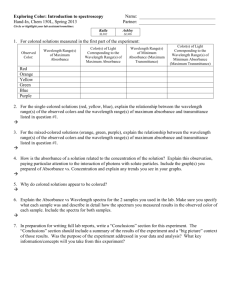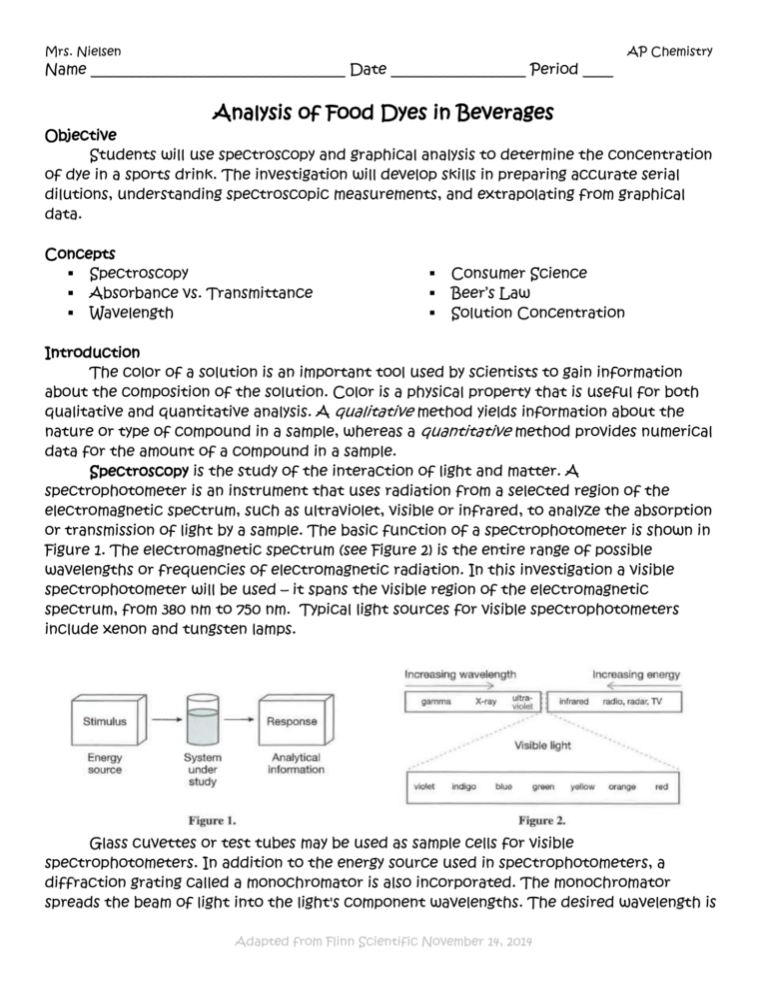Analysis of Food Dyes in Beverages Lab
Beverages Flinn Analysis Of Food Dyes In Beverages Flinn Drawing on the expertise of internationally known interdisciplinary scientists and researchers Food Colorants. Further readingreference material 1.

Analysis Of Food Dyes In Beverages Ap Chemistry
3 Read the entire procedure.

. Analyzing dyes in foods is particularly difficult because these food samples are inherently complex and analysis of low-levels of dye compounds is challenging. So far the only experiences you may have are acid-base or redox titrations. Color measurement varies based on sample type and purpose.
Food dye often referred to as color additives is commonly found in many of the foods we eat for a variety of reasons like enhancing color and making products more fun and appetizing. Food dyes in beverages. AP Chemistry Analysis of Food Dyes in Beverages Beers Law Background There are many ways to determine concentrations of a substance in solution.
Lab Report 7. The beverage we chose was Gatorade Frost Riptide Rush. Cant change a rubric once youve started using it.
Learn vocabulary terms and more with flashcards games and other study tools. Fast HPLC Analysis of Dyes in Foods and Beverages PRP-C18 Download. Construct an appropriate data table to.
Labreport7 - Colorimetric Determination of a Food Dye C. Any major changes could affect their assessment results. Add water if necessary to bring the volume to 400 c.
Brilliant Blue G-250 Dye - Thermo Fisher ScientificSDS-PAGE Analysis - Bio-Rad Laboratories PA 800 Plus Pharmaceutical Analysis System - Sciex Lab Developed Tests. Youve already rated students with this rubric. Obtain the necessary spectroscopic data for the beverage containing FDC Blue 1 food dye.
Determine the concentration micro molar μM of the dye in the beverage and calculate the amount mass of dye in milligrams per liter of beverage. Analysis of Food Dyes in Beverages Lab sheet doc. Quality Assurance and Quality Control With the PA 800 Plus Pharmaceutical Analysis System you can confidently safeguard the success of.
As part of a cooperative lab activity your instructor may assign different. 3 Read the entire procedure. This area will be used by the assessor to leave comments related to this criterion.
1 Turn the spectrophotometer on allow to warm up for 15-20 minutes. Construct an appropriate data table to record measurements and the results of calculations. Chemical and Functional Properties provides an integrative image of the scientific characteristics functionality and applications of color molecules as pigments in food.
Food and Beverage Testing Residue Analysis. Record your calculations and answers in the Lab Report. You will quantify the amounts of food dye in a drink of your choice using UV-Vis spectroscopy and Beers law.
Start studying Analysis of food dyes in beverages -AP CHEM. Old foods were sometimes dyed to provide a more palatable appearance. 2 Based on maximum absorbance of the dye tested select the appropriate wavelength on spectrometer.
View Analysis of Food Dyes in Beverages virtualpdf from ENGLISH 115 at California State University Northridge. There are other properties of a solution that change with concentration such as density conductivity and color. 2 Based on maximum absorbance of the dye tested select the appropriate wavelength on spectrometer.
Chemistry Lab Name _ Period _ Date _ Desk _ Analysis of Food Dyes in. AP Chemistry Lab 1This video is for educational use only. Calculate the mass of dye present in a 20 oz 591 mL bottle of the drink.
Dyes have been used over the centuries to give food more of an appeal to those eating it. Read Online Analysis Of Food Dyes In Beverages Flinn Analysis Of Food Dyes In Beverages Flinn Excerpt from Chemistry and Analysis of the Permitted Coal-Tar Food Dyes For guinea green B - Transfer to a 500 c. Sigman SB Wheeler DE 2004 The quantitative determination of food dyes in.
Color appeal and consistency are critical when factoring in consumer choice and product acceptance. Food Dyes Food dyes are used in many common beverages and foods1 While food dyes serve no nutritional purpose they provide an attractive color to many different sports or soft drinks desserts and even meat. The lab begins with an introductory activity in which students prepare a series of standard dilutions of an FDC Blue 1 stock solution.
Volumetric ask that volume of the master solution which contains 5 grams of the dye. A spectrometer was used to determine which food dyes were present in the sampled beverage red 40 and blue 1 were determined to be present. Pr of essor Sharmila Shakya.
1 Turn the spectrophotometer on allow to warm up for 15-20 minutes. All of the food dyes can be flushed down the sink with plenty of water. The molar mass of FDC Blue 1 dye is 793 gmole.
Today food and beverages are generally dyed for the same reasons to make the product more appealing satisfying and occasionally to hide off. The analysis of food dyes in beverages requires specific measurement techniques that are dependent on the sample type and transparency value of the liquid. General Chemistry I SCC 201 Gener al Chemis tr y SCC 201.
Lab was to determine the food dyes present in a selected beverage their concentration and then replicate the solution within a 20 margin of error.

Analysis Of Food Dyes In Beverages Ap Chemistry

Analysisoffooddyesinbeverageslab Analysis Of Food Dyes In Beverages Lab Purpose The Purpose Of This Lab Is To Use Spectroscopy And Graphical Analysis Course Hero

Comments
Post a Comment